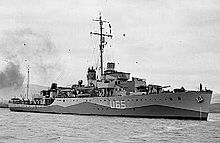HDML – Q1193 – Tamure (P3555)
Read full post here – https://rnznships.com/1479

HMNZS TAMURE – P3555

The H.M.N.Z.S. Tamure coming into berth at Port Lyttelton with two sailors making preparations. Tamure is a 72 foot long motor launch built in 1942
Date 1970-09-12
Gray Harbour Ship Building Co – Aberdeen, Grays Harbour – Washington – Contract Number D.A.N.O.B.S. 587)
The four built by this Company were shipped to Auckland N.Z. from Vancouver on the Mt Robson Park. They were Q1191, Q1192, Q1193, Q1194. They arrived in Auckland on the 25th August 1843, all these craft were commissioned together on the 28th September 1943
Ten H.D.M.L. were retained by the R.N.Z.N. were,
Q1183, Q1184, Q1188, Q1190, Q1191, Q1192, Q1193, Q1194, Q1348, Q1350
These ten H.D,M.L. were reclassified as S.D.M.L. (Seaward Defense Motor Launch) in the mid 1950’s and were used in various roles.
Q1193 which was the Fijian Naval Volunteer Reserve S.D.M.L. Named H.M.F.S. VITI based in Suva was sailed to New Zealand when the Fijian Reserve was disbanded, She was crewed with volunteers from H.M.N.Z.S. ROYALIST and escorted to Auckland by H.M.N.Z.S. KANIERE. in 1959. Refitted and given the pennant number P3555 and handed to the Auckland R.N.Z.N.V.R. as a replacement S.D.M.L. for Q1194 Renamed Ngapona (II) in 1958. Survey 1959-68, Auckland. Sold 3/73.
Served in Fiji (RFNVR) 1955-59
R.N.Z.N.V.R. VESSELS NOW NAMED AFTER THEIR DIVISIONS
Q1193 P3561 Auckland Division H.M.N.Z.S. Ngapona 1959
Also, in 1966 it was decided to refit and convert the four R.N.Z.N.V.R. S.D.M/Ls the same as the Fisheries Protection vessels, so they could be supplemented in the Fisheries Protection role in their respective areas. They were also given fish names. In January 1967 the refits were started and by the end of 1967 all craft had been completed.
Q1193, P3561 Auckland Division, H.M.N.Z.S. NGAPONA – now H.M.N.Z. S TAMURE.

HMNZS Tamure/Ngapona Flotilla of small ships against the backdrop of Rangitoto welcoming the arrival of the Chilean Navy training ship Esmeralda to Auckland. HMNZS Ngapona P3555 (later renamed Tamure) bottom left, the Stanley Bay ferry launch Aotearoa II top left, and the stern of the Navy tug Arataki extreme right.
Attribution
acknowledge Auckland Libraries Heritage Collections
152800010
https://kura.aucklandlibraries.govt.nz/digital/collection/photos/id/90662/
Left RNZN 1973 Sold for charter work. Sank at Tutukaka 1982. Salvaged. Rebuilt as launch Tamure 1987.
Possibly at Te Atutu. Now located at a marine yard in Kopu, Thames












